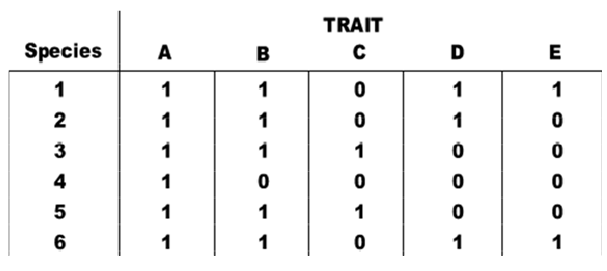In addition to inhibiting the transpeptidation reaction in cell wall synthesis, penicillins may also destroy bacteria by ________.
A. inhibiting protein synthesis
B. inhibiting DNA replication
C. stimulating proteins to form holes in the plasma membrane
D. None of the choices are correct.
Answer: C
You might also like to view...
The table shows the distribution of traits (A-E) in six extant species (1-6). A "0" indicates the ancestral condition, while "1" indicates the derived condition. Based on this data, which species would be considered the outgroup?

A. 1
B. 2
C. 3
D. 4
E. 5
Clarify Question
· What is the key concept addressed by the question?
· What type of thinking is required?
· What key words does the question contain and what do they mean?
Gather Content
· What do you already know about cladistics?
Consider Possibilities
· What other information is related to the question? Which information is most useful?
Choose Answer
· Given what you now know, what information and/or problem solving approach is most likely to produce the correct answer?
Reflect on Process
· Did your problem-solving process lead you to the correct answer? If not, where did the process break down or lead you astray? How can you revise your approach to produce a more desirable result?
In a dihybrid cross of individuals who are AaBb, what proportion of the F2 offspring are expected to have the genotype AABB?
A) 9/16 B) 1/16 C) 1/2 D) 3/16 E) 6/16
Cell membranes are asymmetrical. Which of the following statements is the most likely explanation for the membrane's asymmetrical nature?
A) Since the cell membrane forms a border between one cell and another in tightly packed tissues such as epithelium, the membrane must be asymmetrical B) Since cell membranes communicate signals from one organism to another, the cell membranes must be asymmetrical. C) The two sides of a cell membrane face different environments and carry out different functions. D) Proteins only function on the cytoplasmic side of the cell membrane, which results in the membrane's asymmetrical nature.
Tetracycline is the drug of choice in treating most
A. Gram (-) infections. B. viral infections. C. rickettsial infections. D. Gram (+) bacterial infections. E. dermatophytotic fungal infections.